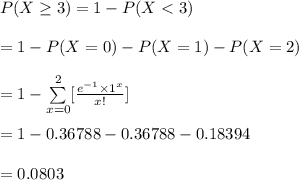
Mathematics, 12.10.2020 01:01 xXCoryxKenshinXx
Astronomers treat the number of stars X in a given volume of space as Poisson random variable. The density of stars in the Milky Way Galaxy in the vicinity of our solar system is one star per 16 cubic light-years, on average. NOTE: Light-years is a distance measure. 7. What is the probability of exactly two stars in 16 cubic light-years? 8. What is the probability of three or more stars in 16 cubic light-years? 9. How many stars would be expected in 4 cubic light years? 10. How many stars would be expected in t cubic light years? 11. How many cubic light-years of space must be studied so that the probability of one or more stars exceeds 0.95? HINT: let `t' represent the unknown region of space, then nd the `t' that gives you the relevant probability.

Answers: 2
Another question on Mathematics

Mathematics, 21.06.2019 18:40
The table shows the results of three plays in a football game. what is the net result of the three plays? football game 1st play 5 yards 2nd play -9 yards 3rd play 12 yards
Answers: 2

Mathematics, 21.06.2019 20:20
How do the number line graphs of the solutions sets of -23 > x and x-23 differ?
Answers: 1


Mathematics, 21.06.2019 22:30
Using the figure below, select the two pairs of alternate interior angles.a: point 1 and point 4 b : point 2 and point 3 c: point 6 and point 6d: point 5 and point 7
Answers: 2
You know the right answer?
Astronomers treat the number of stars X in a given volume of space as Poisson random variable. The d...
Questions


Mathematics, 28.01.2021 20:40

Computers and Technology, 28.01.2021 20:40


Mathematics, 28.01.2021 20:40

Mathematics, 28.01.2021 20:40






Biology, 28.01.2021 20:40

Biology, 28.01.2021 20:40



English, 28.01.2021 20:40


Mathematics, 28.01.2021 20:40

Mathematics, 28.01.2021 20:40

Advanced Placement (AP), 28.01.2021 20:40







